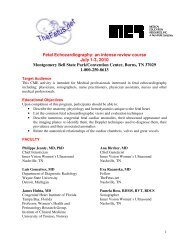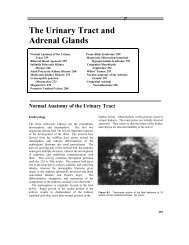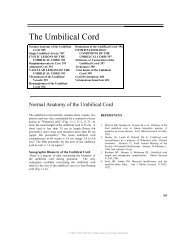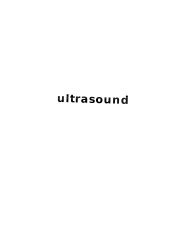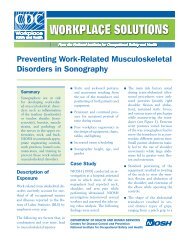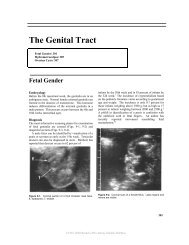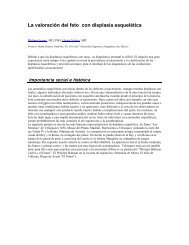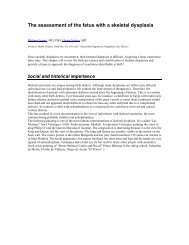Vasa previa - SonoWorld
Vasa previa - SonoWorld
Vasa previa - SonoWorld
Create successful ePaper yourself
Turn your PDF publications into a flip-book with our unique Google optimized e-Paper software.
<strong>Vasa</strong> <strong>previa</strong><br />
Sonographic findings<br />
Figure 3 - Drawing showing the inner view to the uterus, towards<br />
the cervix, demonstrating the anatomical relations in<br />
case of marginal placenta with vessels running at the edge of<br />
placenta and crossing the inner cervical os. By trophotropism,<br />
the marginal edge of the placenta regresses, leaving the vessel<br />
in front of the inner cervical os.<br />
Risk factors<br />
Conditions associated with vessels that run close to the<br />
cervix, such as low-lying placenta (7, 8), placenta <strong>previa</strong><br />
(9), multiple pregnancies (10), and of course multi-lobate<br />
placentas and velamentous insertion [1% of singleton<br />
pregnancy (38), 10% in multifetal pregnancies (11-<br />
13)]. About 2% of velamentous insertions are associated<br />
with a vasa <strong>previa</strong> (14-16).<br />
Placenta membranacea (22) is also a risk factor. It is<br />
less clear why, but in-vitro fertilization increases the risk<br />
of vasa <strong>previa</strong> (17-20), (about 1:300 pregnancies) (21).<br />
Many of these conditions present with vaginal bleeding<br />
which should be considered a possible alert symptom<br />
for vasa <strong>previa</strong>.<br />
Although vasa <strong>previa</strong> can be recognized in grey-scale<br />
as linear structures in front of the inner os (22, 23), the<br />
diagnosis is considerably simpler by putting a flash of<br />
color Doppler (color or power) (24, 25), over the cervix.<br />
Arterial flow but also venous flow can be recognized. Although<br />
some have obtained the diagnosis by perineal<br />
scan (26), a transvaginal image is clearly superior to an<br />
abdominal scan. Some have also advocated the use of<br />
3D (27, 59). Our impression is that 3D does not contribute<br />
much either in the diagnosis nor the mapping of<br />
the vessels since this is quite straightforward from 2D<br />
alone. Since 3D is not universally available, its unavailability<br />
should not be construed as a reason to not seek<br />
vasa <strong>previa</strong>. Nevertheless, 3D allows review of the volume<br />
if an unexpected finding is found at delivery. Another<br />
recent idea is to attempt to diagnose the cord insertion<br />
in the first trimester during the nuchal lucency<br />
screening, at a time when the fetus is less likely to obscure<br />
the cord insertion (28).<br />
Other diagnostic procedures<br />
Alternative methods of diagnosis such as digital palpation<br />
of a vasa <strong>previa</strong>, amnioscopy, Apt, Ogita (29) or<br />
similar (30) tests (fetal blood detection), and palpation<br />
have mostly a historical significance. MRI has been suggested<br />
too (31, 32). All these methods require a greater<br />
expertise then color Doppler thus cannot compare in<br />
speed and availability.<br />
Implications for targeted examinations<br />
In all pregnancies, we recommend sonographic examination<br />
for the placental cord insertion.<br />
In cases where the cord insertion is central and there<br />
is no succenturiate lobe, the likelihood of a vasa <strong>previa</strong><br />
is negligible. Only those cases where the placenta is<br />
low-lying should be examined more carefully. In prac-<br />
Figure 4 - Pathological specimen shows the fetal side of bilobate<br />
placenta with velamentous insertion of the umbilical cord<br />
between the placental lobes. (Courtesy Francois Manson and<br />
TheFetus.net).<br />
Figure 5 - Pathological specimen shows the maternal side of<br />
the bilobate placenta. (Courtesy Francois Manson and TheFetus.net).<br />
Journal of Prenatal Medicine 2007; 1 (1): 2-13 3



